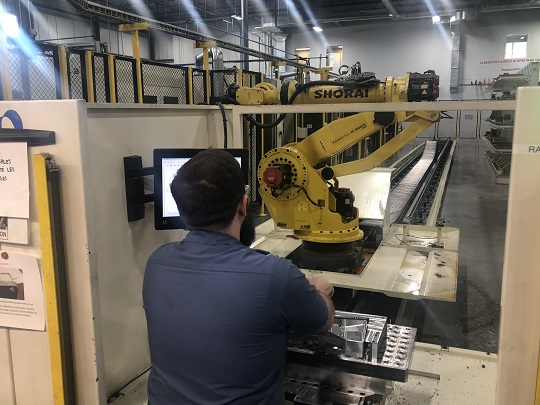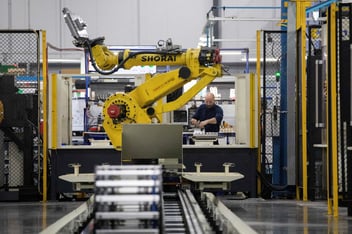
When a Quebec aerospace company realized they had to take their business to the next level to survive, they decided that a merger with an overseas firm was the best strategy for international growth.
Jean Blondin, CEO of Abipa International, says the message from the industry was clear: Go big or stay home.
“The global firms were telling us that they needed stronger, larger suppliers to help them reduce their supply chain risk,” says Blondin, company president for more than a decade. “They wanted to move away from smaller suppliers because for them, it’s a lot of work to sustain supply chains with those businesses.”
And that was the main reason that Abipa Canada decided to take the merger path, he says.
Abipa Canada and its merger strategy
Mergers and acquisitions (M&A) is a general term for a process that combines two separate companies into one entity. One company can purchase another outright (an acquisition) or unite with another firm to create a new business entity (a merger). For Abipa Canada, the optimum strategy was to merge with France’s ARM Group to become a substantially larger company—Abipa International—with a global reach.
Abipa Canada was founded in 1982 and by 2020, it was a good-sized, small-medium enterprise (SME) with about $50 million in annual business. Specializing in precision machining of complex alloy components for engines, landing gear and aero structures, it’s been a supplier to international companies such as Bombardier, Pratt & Whitney, Messier-Bugatti-Dowty, Siemens, Mitsubishi Canada, Héroux Devtek and Figeac Aero.
The company’s merger with ARM Group grew out of hard economic facts. “We knew that the upper limit of the company’s North American business would be about $100 million annually, and that it was going to take a while to reach that level,” says Blondin. “To remain viable, we had to be larger, and we had to develop a significant capacity to invest and grow.”
Enter ARM Group
Groupe ARM or ARM Group originated in the merger of six companies specializing in the machining of mechanical parts. With 330 employees in five sites in France and one in Morocco, the French company has been a leading supplier of parts and assemblies for high-specification markets such as aerospace and defence.
Before the Abipa-ARM Group merger, both companies were of similar size and, prior to the pandemic, each was doing about $50 million in business annually. They began talking to each other because they shared a vision of how the aerospace market was likely to evolve, and what the original equipment manufacturers (OEMs) would expect from companies like theirs. Both felt that their prospects for organic growth were limited, and that they would need strategic partners to break that ceiling.
But it wasn’t just financial growth that mattered; they would also be more attractive to large aerospace firms if they became a single, bigger supplier with a more diverse product range. They could provide one-stop shopping for a wider variety of parts and assemblies, and furnish the products through one robust supply chain. That would fit neatly with the push by the major companies for fewer, larger suppliers, and position Abipa International to grow globally.
A complementary match
“Both Abipa and ARM Group manufacture components and sub-assemblies,” says Blondin. “However, our products don’t overlap very much. ARM Group is more into aluminum and titanium parts, while we do hard metal, and they can make larger components than we can. We’re in different markets in terms of the parts we manufacture, so we complement each other in that way.”
The merger also extends Abipa International’s geographic reach and diversifies its customer base, exposing the new company to less risk than the two original businesses.
“Formerly, we were both exposed to one major customer each,” says Blondin. “But after the merger, each of those big customers represents no more than 35% of our overall business. That has significantly reduced our risk.”
Enter EDC
“Abipa and Export Development Canada (EDC) have worked together since 2017 when the company began using EDC Credit Portfolio Insurance,” says Supun Fernando, Abipa’s commercial account director at EDC.
“The relationship has evolved and Abipa has also used our international trade solutions such as our Foreign Exchange Facility Guarantee. We became involved with the Abipa-ARM Group merger once it had reached the financing stage,” says Fernando.
An M&A strategy can help Canadian aerospace companies achieve two benefits, adds Alexandre Aubrey, EDC’s senior investment manager who worked with the parties involved.
“First, it can help them become large enough to avoid being gobbled up by U.S. and European firms. Second, it can give them international manufacturing capabilities and the ability to service multiple aircraft platforms. Those capabilities are both vital if a supplier wants to remain relevant in the global sector.”
EDC played a key role in the financial side of the merger, says Aubrey. “Aerospace was in a difficult period at that time because of the pandemic, so we came in as an independent institutional investor and equity partner. Fonds de solidarité FTQ, which is the main shareholder of Abipa, led the equity financing, and EDC became an equity partner via our Investment Matching Program. For the due diligence aspect of this transaction, we relied on FTQ’s assessment, which EDC reviewed and confirmed.”
EDC’s interest in the transaction was more than financial—as always, EDC’s goal is to help Canadian companies do well in global markets. “By supporting the merger, EDC is helping us develop our international business,” says Blondin. “EDC can provide the facilities and expertise we need in our international transactions and assist us in finding new customers abroad.”
Did it work?
Now the big question: Have the results been worth it, especially in terms of achieving a critical size that’ll satisfy the demand of the big aerospace companies?
“We’ve definitely hit that target,” says Blondin. “I wouldn’t consider Abipa International to be a SME anymore. We have hundreds of employees across three continents and six manufacturing sites, and already we do $100 million in business annually. We’re now very well-positioned in the global sector—we’re the right size for the work we do, with good equity and good partners. And we have a lot of opportunities because of our geographic reach,” he says.
“Our growth is going to be very significant, and I can see that within five years, we’ll be doing $160 million to $200 million a year. And that’s even if we don’t do any further mergers or acquisitions.”
Any company involved in the global aerospace industry’s supply chains is acutely aware that conditions are evolving rapidly. Smaller firms are less and less likely to be chosen as suppliers by the big aerospace companies, a development that can dangerously reduce their revenues.
The best response to this threat is to become bigger and more diverse. But doing so through organic sales growth is a slow, unpredictable process. A better solution is to expand the company by merging with or acquiring another business.
Abipa Canada (now Abipa International), a Quebec-based aerospace company with about $50 million in annual business, has specialized in precision machining of components for the industry since 1982. Under the leadership of CEO Jean Blondin, its management saw the threat looming and decided that a merger with an overseas company could not only solve the size problem, but also provide a greater international reach.

The aerospace sector and its supply chains
This shift to larger suppliers is happening because each manufacture-supplier relationship requires that the manufacturer exercise an enormous amount of oversight over the supplier, to ensure that that the supplier’s products meet all necessary quality standards. But a small supplier requires the same oversight as a large one, so a supply chain with numerous small companies is considerably more complicated and expensive than one that consists of a limited number of larger suppliers.
“The big aerospace companies are no longer looking for small-scale suppliers with a narrow product range,” says Alexandre Aubrey, a senior investment manager with Export Development Canada (EDC).
“They want larger partners that they can rely on to provide a robust, low-risk supply chain for most of their needs. Consequently, we’re seeing a lot of consolidation in the supply chains of both the global and the Canadian aerospace sectors,” he says.
Suppliers, like Abipa, have recognized this and are trying to grow into larger-scale businesses that’ll be attractive to partners for the major aerospace firms. This is often done via mergers and acquisitions (M&A), in which two separate companies combine into one entity. One company can purchase another outright (an acquisition) or unite with another firm to create a new business entity (a merger).
Setting up the merger
Any M&A deal requires a considerable commitment of time, resources and people. Well aware of this, Abipa took the time to establish solid operational and governance foundations before the company began the process.
“All our senior managers have large-company backgrounds,” says Blondin. “As a result, we were able to develop the governance maturity necessary for a merger. Our first step was to create an M&A committee within the board of directors, and that committee defined the characteristics we were looking for in a potential target company.
“Some of these criteria, for example, involved access to new customers, de-risking our supply chains, finding complementary technology, selecting a suitable geographical location and so on. Identifying those factors was crucial to the whole project, to make sure we chose the right partner. Once we’d done that, we were ready to look for potential merger prospects because we knew exactly what criteria they’d have to meet.”
Starting the process
For Abiba, the best merger target seemed to be Groupe ARM or ARM Group, which was similar in size to Abipa and specialized in the machining of mechanical parts for high-specification markets such as aerospace and defence. Better yet, Abipa and ARM Group had already discussed joining forces because they shared a vision of how the aerospace market was likely to evolve, and what the big manufacturers would expect from companies like theirs.
As a first step, Abipa visited all of ARM Group’s five sites in France and one in Morocco to carry out its due diligence. The resulting report went to Abipa’s M&A committee, which concluded that the two companies could be a good fit—ARM Group met the criteria the committee had established and had the knowledge, expertise and customer base that Abipa needed.
“The second thing we did was hire a major accounting firm to help us carry out the deal,” says Blondin. “They worked with us until we were a couple of days from signing the merger papers, but then everything went sideways.”
The pandemic and other challenges
The “sideways” was the unexpected outbreak of COVID-19 in March 2020. The merger process came to a halt for about six months while the global industry tried to assess what was going to happen. Eventually, some of the dust settled, but given the pandemic-related changes in the industry, Abipa decided it should redo its assessment and due diligence to decide whether the deal should still go forward.
“We felt that this had become an internal decision, so we didn’t need the accounting firm anymore,” says Blondin.
“We used our own in-house expertise and worked closely with our long-term financial partner, Fonds de solidarité FTQ, to reassess the numbers. FTQ’s people are experts in evaluation, so with their help, and with the help of our lawyers and tax specialists, we eventually finalized the deal and became Abipa International.”
Even so, the process presented numerous challenges despite all the expert help. “We discovered that doing an international merger isn’t easy,” observes Blondin.
“French law in this area is completely different from Canadian law, for example, and bringing two business cultures together is a lot of work. We learned a great deal, but it was a much more complex transaction than merging with a Canadian company would have been.”
EDC became involved at the financing stage of the merger by working with FTQ, the majority owner of Abipa. EDC came into the deal as an equity partner via our Investment Matching Program. “For the due diligence side of the transaction, we relied on FTQ’s assessment, which we reviewed and confirmed.”
After the merger
The importance of preparing for the post-merger or post-acquisition phase can’t be overemphasized, Blondin insists.
“This preparation should be done while you’re still working on the transaction,” he advises. “Leaving it till the papers are signed is far too late—once the deal is closed, everything happens fast and becomes complicated, so you need to plan every step in advance.
“Your post-signing strategy will define how the new company will operate in vital areas such as financial management, operations, human resources, communications and IT, so it’s important to get it right.”
To prepare for the post-merger stage, Abipa created a group to assess what was needed.
“The group included people from both companies, and we created a plan that covers short-term, medium-term and long-term needs,” says Blondin. “But for this process to work, you have to ensure that everybody understands where you’re going and that they’re committed to integrating the processes and approaches of the two companies.
“And in an international deal like ours, handling the cultural aspect is also very important, since you’re blending two ways of doing business that may be very different, but must adapt to working together,” he says
Six tips for a successful merger or acquisition
- Determine whether you have the necessary operational maturity in your company. If you don’t, take time to develop these resources before you forge ahead.
- Ensure that you have the right financial partners. Are they looking for short-term or long-term results? Are they ready for a commitment?
- Be sure you have a vision and a strategy for achieving that vision, as well as an instrument, like a committee, to support and advise you as you move forward.
- Get expert help early on such as legal, accounting, financial, negotiation and due diligence services. For international transactions, use advisory firms that have a presence or a partner in the country where your target company is located. EDC’s Export Help Hub covers the globe and can connect you with EDC trade advisors who can answer your questions, help you understand your challenges and help you find solutions for them.
- Do your homework about the target business’s country. Look at its political and economic landscape, legal and regulatory environment (e.g., Buy America in the United States), free trade agreements, banking system and business culture.
- Prepare a post-transaction strategy and use it to create a detailed plan for integrating the systems and operations of the two companies.








